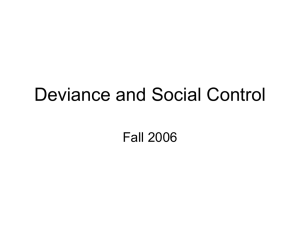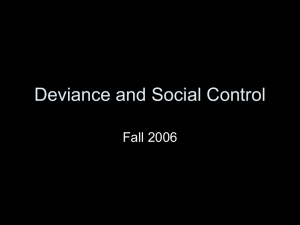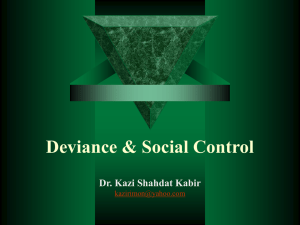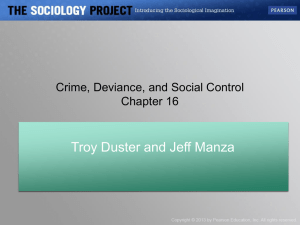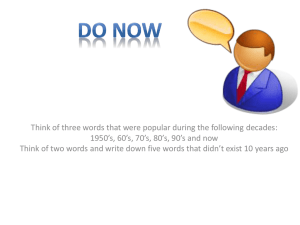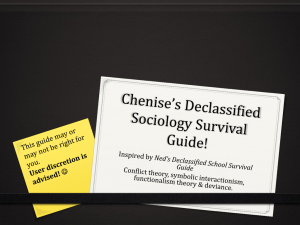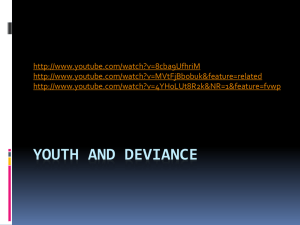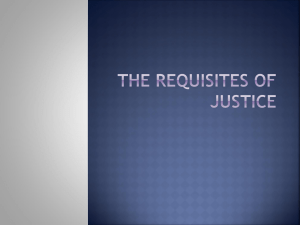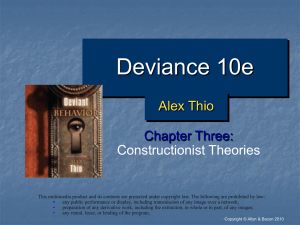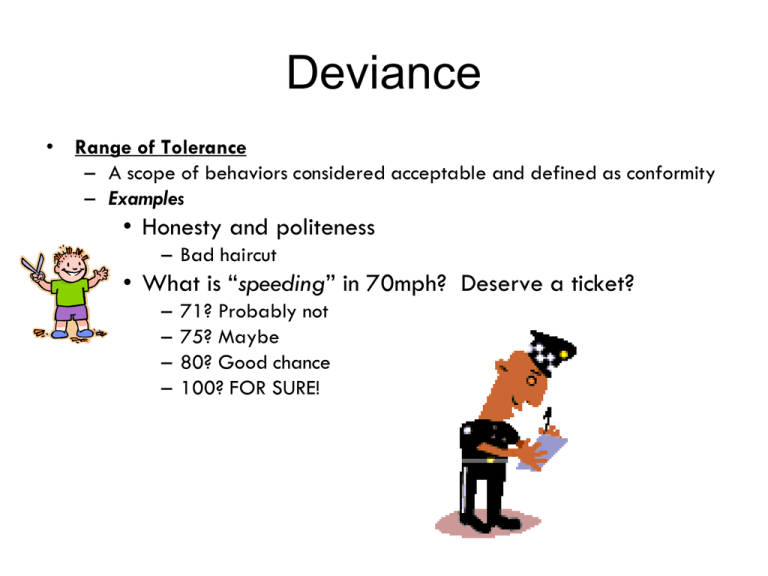
Deviance
• Range of Tolerance
– A scope of behaviors considered acceptable and defined as conformity
– Examples
• Honesty and politeness
– Bad haircut
• What is “speeding” in 70mph? Deserve a ticket?
–
–
–
–
71? Probably not
75? Maybe
80? Good chance
100? FOR SURE!
Types of Deviance
• Overconformity “positive
deviance”
– Involves behavior that
overconforms to social
expectations
• Leads to imbalance and
perfectionism
• Can be AS harmful as
negative deviance
– Examples
• Anorexia
• Body Builder
• “Perfect” Students
– Knows answer to
EVERY question
– 100% A+ on all tests
and papers
– Perfect attendance
•
Underconformity “negative
deviance”
– Involves behavior that underconforms to social expectations
people either reject, misinterpret,
or are unaware of the norms
– Examples:
• Obesity
• Unmotivated Students
– Lack of participation
– Sleep in class
– Unexcused absences
– Fail tests and papers
Deviance depends on…
– Time
• Fashion and grooming change
with time, like the Founding Fathers Fashion
– Place
• Where behavior occurs determines whether it is appropriate or deviant
– Cheering/booing at Football game vs. in class
– Situation
• Takes precedence over place in determining appropriateness of actions
– Laughing in class vs. laughing in class during a moment of
silence
– Culture
• Most influential in defining deviance
– Men greeting each other
» US: Hand shake
» Japan: Bow
» Europe: Kiss on cheek
Symbolic Interactionist Approach to
Deviance
• Primary Deviance
– Deviance involving occasional breaking of norms that are
NOT a part of a person’s lifestyle or self-concept
• Example: Honor roll student comes home past curfew one night
• Secondary Deviance
– Deviance in which an individual’s life and identity are
organized around breaking society’s norms
• Example: The “robbers” in Ocean’s 11 had a criminal history
because they had broken the law on multiple occasions.
Structural Functionalist Approach to Deviance
• Strain Theories: Deviance is more likely to occur when a gap exists
between cultural goals and the ability to achieve these goals by legitimate
means
• Innovation: Individual accepts goal of success but uses illegal means to
achieve it
– Ex: Drug Dealers
• Ritualism: Individual rejects goal of success but continues to “go through the
motions” without believing in the process
– Ex. Teacher who doesn’t care about engaging students, but still comes to work
• Retreatism: Individual rejects both legitimate means and approved goals
(Given up on life)
– Ex. Bag lady
• Rebellion: Individual rejects both success and the approved means for
achieving it; substitutes their own goal and means to achieve it
– Ex. Militia Member
•
Social Learning Theories
all behavior (including deviance) is learned
through social interaction
– Differential Association: individuals learn
deviance in proportion to the number of
deviant acts they are exposed to
• Primary relationships with parents,
siblings, and close friends have the
greatest impact on our behavior.
– “birds of a feather flock
together”
– Differential Reinforcement: depending on
whom an individual associates with, normviolating behavior may be either
positively rewarded or negatively
sanctioned
• Ex. How friends react when they find
out you shoplifted will help determine
whether you will repeat the action
Control Theory
• Compliance with social norms
requires strong bonds between
individuals and society
• Social Bond Theory
– Some people do not commit
deviance because they have
developed a strong social bond,
consisting of an attachment to
parents, school, church, etc.
• Stronger the social bond, less
likely to be involved in
deviant activities
• Weaker the social bond,
easier it is for an individual
to break violate social norms
All crime is deviance…but all
deviance is NOT a crime.
•
Crime: any act that violates a criminal law
– Violent offenses: crimes against people
• Ex. Homicide, aggravated assault, forcible rape, robbery
– Nonviolent offenses: crimes against property
• Ex. Burglary, larcenry-theft, auto theft, and arson
– White Collar Crime- crime committed by high- status people in their
occupations. This crime costs the U.S. 18 times the cost of street crime. These
criminals get treated more leniently than other criminals.
• Ex. Embezzlement, fraud, insider trading, copyright violations, tax evasion,
and antitrust law violations
– Public Order “Victimless” Crimes
• Ex. Prostitution, illegal gambling, illegal drug use
Correctional Systems
• Deterrence: Discouraging criminal acts by threatening punishment
– Capital Punishment
• Rehabilitation: Process of changing or reforming a criminal through
resocialization
– Ex. Providing social and work skills to reform criminals
• Retribution: Punishment intended to make criminals pay compensation for
their acts
– Ex. Incarceration: Method of protecting society from criminals by
keeping them in prison
• Recidivism: Repeated offenses by those who have already been convicted
of crimes
Other Options for Reforming
Individuals
• Short Prison time + Probation- to shock violators
into realizing prison realities and getting a
“chance”
• Community programs- take violators out of
prison and into the community to readjust them
to life outside
• Referral to community centers- keeping violators
out of prison so that they don’t learn prison
norms
WHO SHOULD PAY FOR THE
REHABILITATION OF THESE CRIMINALS
• Holding criminals in prison, rehabilitation centers, and other forms of
probation cost money
– Food
– Patrolmen
– Electricity, cable
– Facilities
– Education materials
– Medical Expenses
– Therapists, educators, psychiatrists
• Is it the criminals’ fault that they acted deviantly, or is there
something wrong with society that these criminals cannot get by
without committing crimes?
• What else could be done with these criminals?
Conflict Approach to Deviance
• Conflict Theory of Deviance:
view deviance as arising when
groups with power attempt to
impose their norms and values on
less powerful groups
– Prevent behavior that those in
control see as threatening to
their interests
• Example
– Lack of respect for
authority
– Destruction of property
• Power and Deviance
– Distributed on basis of age,
race, sex, religion, and politics,
and social class
– Power plays a role in creating
and enforcing rules of society
• Who and what are deviant?
– Example
• Administrators>Teachers
• Teachers>Students
What new crimes exist with new
technologies available?
• Credit card fraud
• Web cam violations of privacy
• Identity Theft
• What can be done to reduce these tech
crimes?



